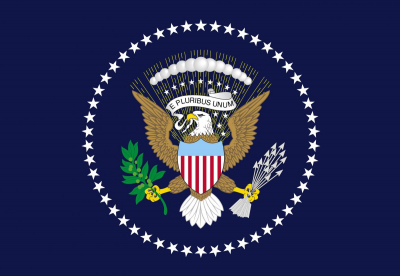The Second Bank of the United States was the second federally authorized Hamiltonian national bank in the United States. Located in Philadelphia, Pennsylvania, it was chartered from February 1816 to January 1836. The Bank's formal name, according to section 9 of its charter as passed by Congress, was "The President Directors and Company of the Bank of the United States". While other banks in the US were chartered by and only allowed to have branches in a single state, it was authorized to have branches in multiple states and lend money to the US government.
A private corporation with public duties, the Bank handled all fiscal transactions for the U.S. Government, and was accountable to Congress and the U.S. Treasury. Twenty percent of its capital was owned by the federal government, the Bank's single largest stockholder. Four thousand private investors held 80% of the Bank's capital, including three thousand Europeans. The bulk of the stocks were held by a few hundred wealthy Americans. In its time, the institution was the largest monied corporation in the world.The essential function of the Bank was to regulate the public credit issued by private banking institutions through the fiscal duties it performed for the U.S. Treasury, and to establish a sound and stable national currency. The federal deposits endowed the Bank with its regulatory capacity.Modeled on Alexander Hamilton's First Bank of the United States, the Second Bank was chartered by President James Madison, who in 1791 had attacked the First Bank as unconstitutional, in 1816 and began operations at its main branch in Philadelphia on January 7, 1817, managing 25 branch offices nationwide by 1832.The efforts to renew the Bank's charter put the institution at the center of the general election of 1832, in which the Bank's president Nicholas Biddle and pro-bank National Republicans led by Henry Clay clashed with the "hard-money" Andrew Jackson administration and eastern banking interests in the Bank War. Failing to secure recharter, the Second Bank became a private corporation in 1836, and underwent liquidation in 1841.
The president of the United States (POTUS) is the head of state and head of government of the United States of America. The president directs the executive branch of the federal government and is the commander-in-chief of the United States Armed Forces.
The power of the presidency has grown substantially since the office's establishment in 1789. While presidential power has ebbed and flowed over time, the presidency has played an increasingly strong role in American political life since the beginning of the 20th century, with a notable expansion during the presidency of Franklin D. Roosevelt. In contemporary times, the president is also looked upon as one of the world's most powerful political figures as the leader of the only remaining global superpower. As the leader of the nation with the largest economy by nominal GDP, the president possesses significant domestic and international hard and soft power.
Article II of the Constitution establishes the executive branch of the federal government and vests the executive power in the president. The power includes the execution and enforcement of federal law and the responsibility to appoint federal executive, diplomatic, regulatory, and judicial officers. Based on constitutional provisions empowering the president to appoint and receive ambassadors and conclude treaties with foreign powers, and on subsequent laws enacted by Congress, the modern presidency has primary responsibility for conducting U.S. foreign policy. The role includes responsibility for directing the world's most expensive military, which has the second largest nuclear arsenal.
The president also plays a leading role in federal legislation and domestic policymaking. As part of the system of checks and balances, Article I, Section 7 of the Constitution gives the president the power to sign or veto federal legislation. Since modern presidents are also typically viewed as the leaders of their political parties, major policymaking is significantly shaped by the outcome of presidential elections, with presidents taking an active role in promoting their policy priorities to members of Congress who are often electorally dependent on the president. In recent decades, presidents have also made increasing use of executive orders, agency regulations, and judicial appointments to shape domestic policy.
The president is elected indirectly through the Electoral College to a four-year term, along with the vice president. Under the Twenty-second Amendment, ratified in 1951, no person who has been elected to two presidential terms may be elected to a third. In addition, nine vice presidents have become president by virtue of a president's intra-term death or resignation. In all, 45 individuals have served 46 presidencies spanning 58 full four-year terms.Joe Biden is the 46th and current president of the United States, having assumed office on January 20, 2021.

1841Aug, 16
U.S. President John Tyler vetoes a bill which called for the re-establishment of the Second Bank of the United States. Enraged Whig Party members riot outside the White House in the most violent demonstration on White House grounds in U.S. history.
Choose Another Date
Events on 1841
- 9Mar
United States v. The Amistad
The U.S. Supreme Court rules in the United States v. The Amistad case that captive Africans who had seized control of the ship carrying them had been taken into slavery illegally. - 16Aug
Second Bank of the United States
U.S. President John Tyler vetoes a bill which called for the re-establishment of the Second Bank of the United States. Enraged Whig Party members riot outside the White House in the most violent demonstration on White House grounds in U.S. history. - 24Sep
Kingdom of Sarawak
The Sultanate of Brunei cedes Sarawak to the United Kingdom. - 13Nov
Hypnotism
James Braid first sees a demonstration of animal magnetism, which leads to his study of the subject he eventually calls hypnotism.

 English
English  español
español  français
français  português
português  русский
русский  العربية
العربية  简体中文
简体中文 